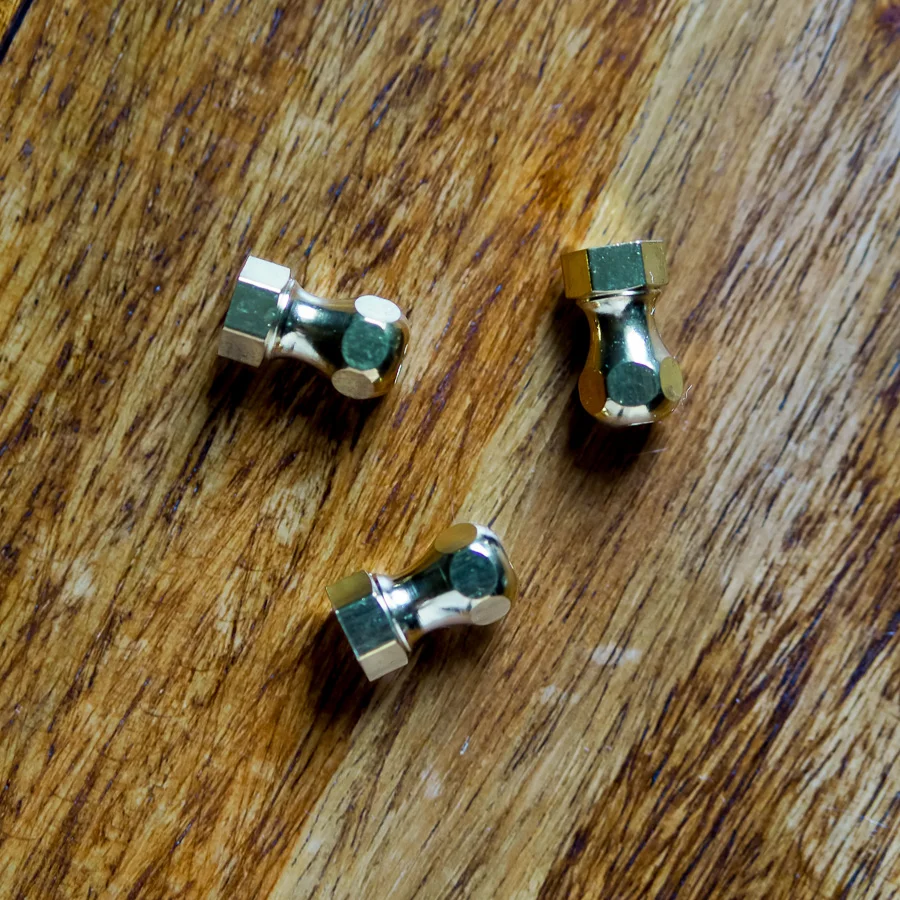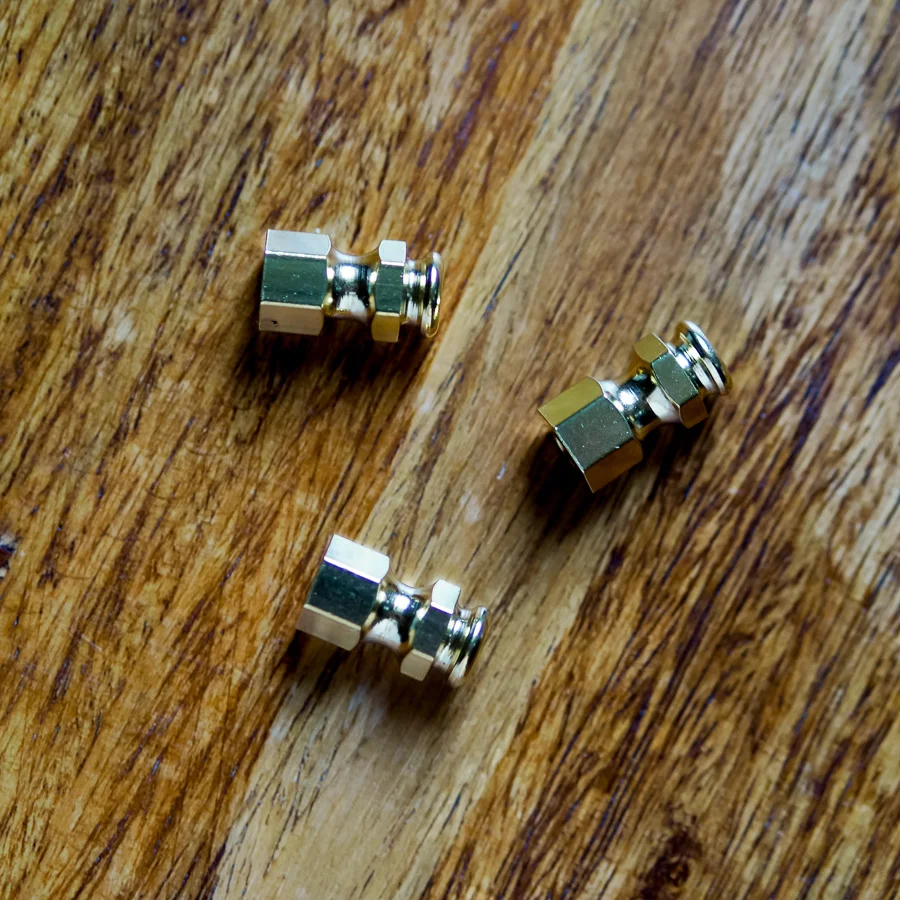Brooks Banjos Features
Each Brooks Banjo includes numerous custom options to make your banjo personalized and unique. The most popular model is the “Spartan”, named for the 1956 Chevy Spartan school bus in which my first banjos were built.
Brooks Spartan banjos include the following features:
Walnut or cherry neck ($75 extra for walnut)
Choice of peghead shape
Ebony or figured walnut peghead overlay
Gotoh tuners with black buttons
Ebony fingerboard
25.5” scale length
Fretted or fretless
Frailing scoop or 22 frets
Double action truss rod
Gold pearl side or fret position markers
11” or 12” rim in dyed maple, cherry, or walnut ($75 extra for walnut)
Choice of 16 handmade brass hooks and shoes
Handmade notched brass tension hoop
Handmade ¼” rolled brass tone ring
Hand stretched goat skin head
BB cast bronze tailpiece
Pricing for custom options can be found in the Order From (scroll down on the ordering page).
Custom Options
Click the links below for more info.
Peg heads include your choice of ebony overlay or figured walnut overlay, as well as the option of an inlaid coin on the front or back of the head.
Click the images below to see banjos with that headstock shape on the blog.
BB Coin
The Brooks Banjos BB coins celebrate 2019 marking 20 years in business. They are penny sized bronze coins struck on 1880 era machinery and were designed with Eric Bagdonas, my fellow stringband mate. You can choose which side of the coin is displayed on your banjo peg head.
Click on the image to see the coins in detail.
Here are the fingerboard options that you may choose from:
Fretted with 4mm gold pearl position markers on playing area
Fretted with 2.5mm gold pearl side dot position markers
Fretless with blank playing area
Fretless with flush frets to the 17th fret
Brass or Nickel Fretless Plate to 5th, 7th or 9th fret with blank ebony fingerboard (extra charge)
Brass or Nickel Fretless Plate to 5th, 7th or 9th fret with flush frets to 17th fret (extra charge)
Brass or Nickel Plate in Scoop Area (extra charge)
Whole Fingerboard Plate (extra charge)
My standard fingerboard is plain ebony, but I have made some fingerboards with other woods and inlays by special request.
Frailing Scoop
As a maker I encourage a frailing scoop, as they give you room to get your thumb under the strings and make a nice low action over the fingerboard which is easy to play. A scoop also requires more of a neck angle than no scoop, giving the banjo a bit more drive. I'm not a scoop stickler however, and do offer banjos with no scoop and 22 frets, or 17 frets with a blank non-scooped frailing area.
Walnut and cherry necks are available for all banjos, with some other options available as upgrades or when I acquire a stock of interesting wood.
Past banjos have had necks made from walnut, cherry, birdseye maple, curly maple, figured walnut, and ash.
The type of wood used for a banjo rim will have a subtle effect on the sound, maple being the fullest and deepest tone with lots of volume. Walnut is very warm sounding and as in color, a bit darker sounding than maple with plenty of volume as well. Walnut also has overtones that sound like an old banjo to me. Cherry rims sound similar to walnut, but with a subtle growl, same old banjo overtones as walnut and they can really put out a lot of volume, somewhat aggressive sounding at times. Cherry rims get deeper red in color as the years go by, when they are exposed to light. So, keep your cherry banjo out on a stand or hanging on the wall. Cherry makes the lightest weight banjo. As with all of my banjos, I make my rims here in the shop. Tension hoops are also made in the shop along with the 1/4" rolled brass tone rings.
You can see banjos on the blog with walnut rims, cherry rims, dyed maple rims, and silverspun rims.
Silverspun Rims
I have been making these silverspun rims by hand since 2000 and they are the finest rim I make. The sound of these rims has subtle beauty. They have a mellow bell tone, clear and pretty notes with plenty of volume.
Silverspun rims have nickel silver turned over a 1/4” rolled brass hoop on the top of the rim and the nickel is turned over a 3/16” brass hoop on the bottom. They are 2 5/8" deep and 3/8" thick. These are two ply rims and are available in walnut, cherry, or maple.
Rimcaps
A rim cap is decorative wood glued onto the bottom edge of the banjo rim. They are mostly for decoration, but do add some stability to the rim as well as protection if you are using ebony. I offer figured walnut or ebony for rim caps. Walnut is a beautiful addition to cherry and maple rims, it is however prone to buckle rash as it is a softer wood than ebony. Please note that rimcaps are not available on silverspun rims.
The number of hooks has a big impact on how your banjo will look. I add “L” to indicate how many hooks a Brooks Banjo has, ranging from my simplest 10L Nylgut strung banjos to the hefty 30L banjo.
The 30L banjo is inspired by the good old banjos with a ton of hooks. Do more hooks produce a better sound? They do sound more resonant, not really any more bass or treble — just more presence. More present in sound and in weight, add a tone ring and it is a substantial piece of machinery.
You can see examples on the blog of 10L, 14L, 16L, 24L, and 30L banjos.
Every banjo has one of two types of heads: a skin head or a synthetic head. When you order a banjo, you choose the type of head.
Skin head - My favorite banjo head option for a variety of reasons. See below for more information about skin heads. A skin head had the richest sound of the three choices.
Fiberskin head - A synthetic head that has the look of a skin head. A little thicker than Renaissance head. Deeper sound than a Renaissance head, not as much volume.
Renaissance head - A synthetic head that is a transparent amber color, which I color to a brownish color. Lots of volume.
More About Skin Heads
To me a goat skin head is the best choice for a banjo, they look great and they add a lot of character and depth to the sound of your banjo. While I can’t promise a skin head will never need fussing with, I can say that I expose each head to high humidity, then dryness and do the adjustments the head needs until it doesn’t respond to the different humidities and sets stable. I do this before I ship each banjo out. I also use a square flesh hoop to keep the hide from ever slipping.
A. A. Farland, a banjo maker, teacher, and performer, used to put this quote on his banjos:
“If the tone ain’t right, the head ain’t tight”.
I have to agree. If your banjo isn’t sounding right and isn’t responding like it used to, tighten the head. I generally set my string action 1/8” at the 17th fret. If your strings are lower than that, tighten the head until the strings reach that height again. You only need to worry about a head popping if you leave your banjo in a hot car, in direct sunlight, in a hot tent, or if the head gets a small hole or rip in it.
You need to worry about loosening your head only if you are heading from extreme moisture to extreme dryness. In this case, loosen each nut about two turns, before you head to the dry climate. Then adjust it accordingly when you reach the drier climate.
I make banjos with or without a tone ring. Here’s a list of options, along with my attempt to describe the tonal characteristics.
1/4” Round Brass Tone Ring: Classic old-time banjo sound with warm notes and a somewhat trebly low end and with a ringy responsive high end. Skin heads add more warmth to the sound.
No Tone Ring: Banjos have a 1/4” round lip turned into the top of the rim. Lightweight and woody sounding, with quick diminishing plunky notes. Not as ringy as a brass ring.
Bacon Tone Ring: A Bacon tone ring adds more bass and character to the notes. The high end is well rounded and warm.
Silverspun: Very warm rich and subtle, sounds even bassier than a Bacon ring. Simply put it is a very pretty sounding banjo A very unique sound.
Silverspun with a Bacon Tone Ring: Brighter and more presence than a regular Bacon rim, more of that big internal sound. Boxy sounding like a guitar.
Silverspun with a Whyte Laydie Tone Ring: A lot of volume, bright, bassy and clear. They will hear you at the back of the dance. This banjo can fill a room with sound.
Silverspun with a Dobson tone ring: These have a deep chimey sound. Lots of sustain.
BB Cast Bronze Tailpiece
The BB Tailpiece is my own design. They are cast bronze and have a nice floral pattern with the letters BB. This tailpiece adds a bit more tension to the head compared to a no-knot, which in turn gives the banjo a bit more punch. A nice touch is that this tailpiece is attached with a regular rim hook.
No-Knot Tailpiece
The no-knot tailpiece is a popular choice for open-back banjos, and it's been in use for more than 100 years. As the name implies, the strings can be attached without tying knots, but if you prefer you can still use knots to attach the strings.
I started reproducing vintage banjo hardware in 2000, working with a small foundry that I still do business with. For 10 years, a local machinist friend made all of the small brass parts I use. From 2014-2016, my machinist friend trained me to make hardware on my own and we tooled up the shop to replicate the brass banjo hardware used on my favorite banjos from the 1880's and 1890's.
Antiqued Finish: I use a light acid bath to give the brass an aged look, and after aging I polish the hardware to a nice polished luster. If shiny brass parts aren't your thing, antiquing them gets rid of the gold brass color, but still has a beautiful shine to the patina.
Shoes
The shoes are attached to the rim, and hold the hooks that hold down the tension hoop. Shoes come in several styles, and you also have a choice of nuts. Your shoe choice can have a dramatic effect on the appearance of your banjo.
The two options that I most often recommend are the brass ball end shoes or an upgrade to my elegant cast bronze butterfly shoes.
Hook Nuts
Hook nuts attach to the bottom of the rim hooks. Hook Nut C is not offered as an option for Brooks Banjos as it is a smaller nut that is more suitable for vintage banjo rims.














